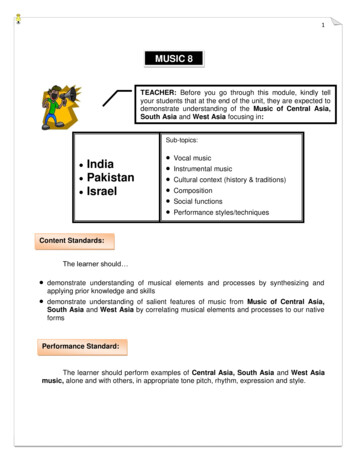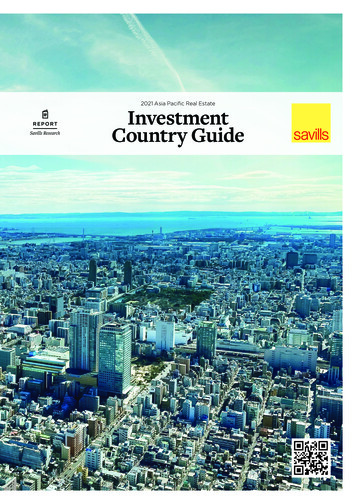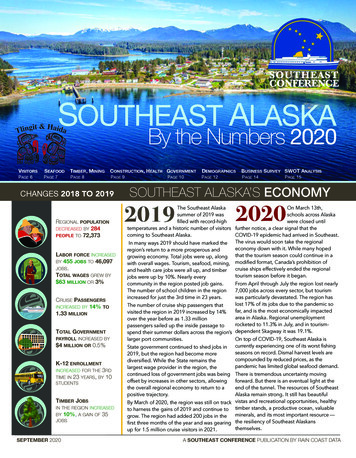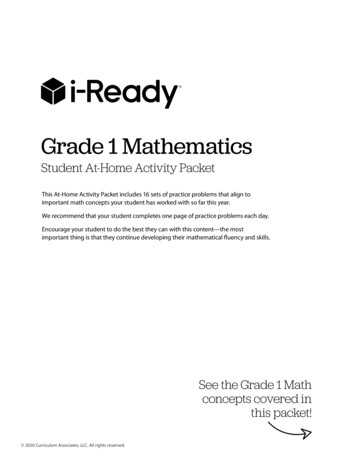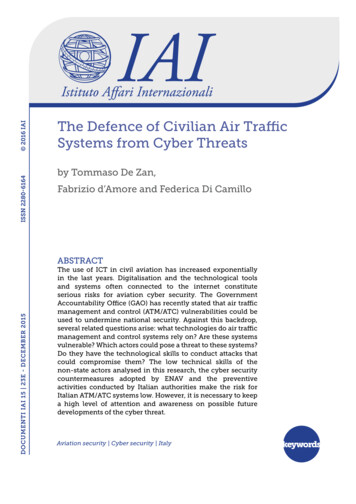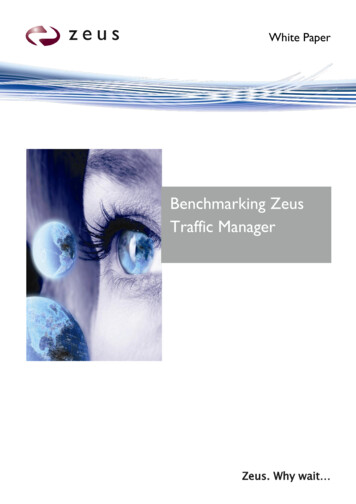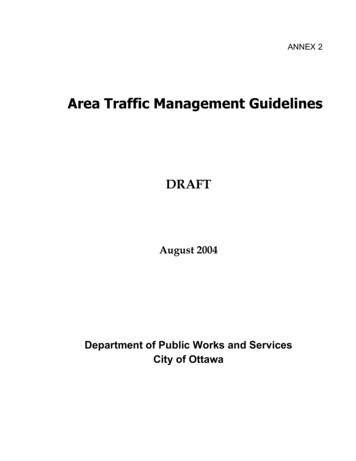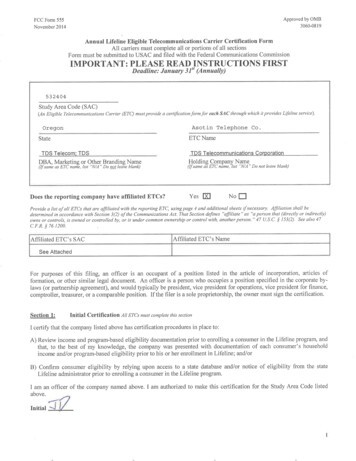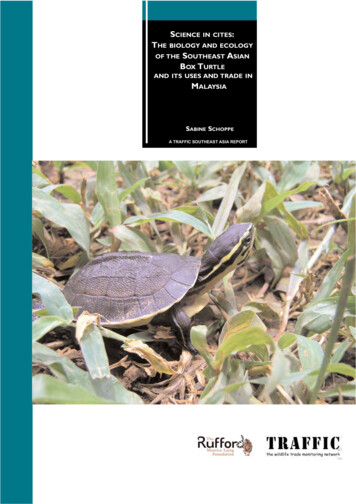
Transcription
SCIENCETHEIN CITES:BIOLOGY AND ECOLOGYOF THESOUTHEAST ASIANBOX TURTLEAND ITS USES AND TRADE INMALAYSIASABINE SCHOPPEA TRAFFIC SOUTHEAST ASIA REPORT
Published by TRAFFIC Southeast Asia,Petaling Jaya, Selangor, Malaysia 2008 TRAFFIC Southeast AsiaAll rights reserved.All material appearing in this publication iscopyrighted and may be reproduced withpermission. Any reproduction in full or inpart of this publication must credit TRAFFICSoutheast Asia as the copyright owner.The views of the authors expressed in thispublication do not necessarily reflect thoseof the TRAFFIC Network, WWF or IUCN.The designations of geographical entities inthis publication, and the presentation of thematerial, do not imply the expression of anyopinion whatsoever on the part of TRAFFICor its supporting organizations concerningthe legal status of any country, territory, orarea, or its authorities, or concerning thedelimitation of its frontiers or boundaries.The TRAFFIC symbol copyright andRegistered Trademark ownership is held byWWF. TRAFFIC is a joint programme ofWWF and IUCN.Layout by Noorainie Awang Anak,TRAFFIC Southeast AsiaSuggested citation: Sabine Schoppe (2008):Science in CITES: The biology and ecology of theSoutheast Asian Box Turtle and its uses and trade inMalaysiaTRAFFIC Southeast Asia, Petaling Jaya,Selangor, MalaysiaISBN 9789833393183Cover: Only few hatchlings of the Southeast Asian Box TurtleCuora amboinensis reach maturityPhotograph credit: Sabine Schoppe/TRAFFIC Southeast Asia
SCIENCE IN CITES:THE BIOLOGY AND ECOLOGY OF THE SOUTHEASTASIAN BOX TURTLE AND ITS USES AND TRADE INMALAYSIASabine Schoppe/TRAFFIC Southeast AsiaSabine SchoppeCommercial traps used for the collection of the of the Southeast AsianBox Turtle Cuora amboinensis catch all size classesScience in CITES:The biology and ecology of the Southeast Asian Box Turtle Cuora amboinensis and its uses and trade in Malaysia
CONTENTSGlossary and AcronymsiiiAcknowledgementsviiExecutive SummaryviiiIntroduction1MethodologyBiology and Ecology of the Southeast Asian Box TurtleConservation status of the Southeast Asian Box TurtleLaws and regulations for the conservation of freshwater turtlesPast trade levels of the Southeast Asian TurtleCurrent trade of the Malayan Box TurtleAlternative production systemsAbundance of the Malayan Box Turtle in the wild34445566Results and DiscussionHabitatRole in the ecosystemMorphologyGrowth and reproductionConservation status of the Southeast Asian Box TurtleLaws and regulations for the conservation of freshwater turtlesPeninsular MalaysiaSabah and SarawakTrade regulations for the Malayan Box TurtlePast trade levels of the Southeast Asian Box TurtleCurrent trade of the Malayan Box TurtleUsers of the Malayan Box TurtleUses of the Malayan Box TurtleQuantity and quality of trade in the Malayan Box TurtleTrade routesAlternative production systemsAbundance of the Malayan Box Turtle in the s47Recommendations47Science in CITES:The biology and ecology of the Southeast Asian Box Turtle Cuora amboinensis and its uses and trade in Malaysiaii
GLOSSARY AND ACRONYMSAdult – Referring to a sexually mature animal. Here specifically referring to specimens of freshwaterturtles which have established external sexual dimorphism.Anon. – Anonymous.Article IV – Under the convention text of CITES (see below), concerning the Regulation of Trade inSpecimens of Species Included in Appendix II. The export of any specimen of a speciesincluded in Appendix II shall require the prior grant and presentation of an export permit. Anexport permit shall only be granted when the following conditions have been met: (a) aScientific Authority of the State of export has advised that such export will not be detrimentalto the survival of that species; (b) a Management Authority of the State of export is satisfiedthat the specimen was not obtained in contravention of the laws of that State for the protectionof fauna and flora; and (c) a Management Authority of the State of export is satisfied that anyliving specimen will be so prepared and shipped as to minimize the risk of injury, damage tohealth or cruel treatment.Assurance population – Referring to those populations of the Southeast Asian Box Turtle that areprotected and that live under conditions that provide nutrition, mates and an environment thatallows population growth.Category I – One of three categories for species under Review of Significant Trade. A Category Ispecies is considered a species of urgent concern and shall include species for which theavailable information indicates that the provisions of Article IV, paragraph 2 (a), 3 or 6 (a), arenot being implemented.CITES – The Convention on International Trade in Endangered Species of Wild Fauna and Flora.CN – ISO code for China.Commensal – Here referring to turtle species that are commensals of man, meaning turtles thatinhabit anthropogenically disturbed habitats.Consumption trade – Trade in freshwater turtles and tortoises, including the Southeast Asian BoxTurtle, for food.Exporter –Referring to a trader who exports turtles for commercial purposes.Fecundity – The potential reproductive capacity of an organism or population, measured by thenumber of eggs. Fecundity can increase or decrease in a population according to currentconditions and certain regulating factors such as food supply, birth, death, growth rate.Femorals – 2nd to the last plates on the turtle plastron.Gross exports – Referring to the definition of the CITES Trade Database which is “the total quantity(re-)exported of a given commodity”.Gross imports – Referring to the definition of the CITES Trade Database which is “the total quantityimported of a given commodity”.Hatchling – A life history stage. Here for the Southeast Asian Box Turtle defined as the stage fromhatching until the egg tooth is lost, which is usually 10-19 days after hatching.HK – ISO code for Hong Kong.IATA – International Air Transport Association, which has created standards for the transport of liveanimals by air.ID – ISO code for Indonesia.Ikan – Bahasa Malaysia word for “fish”.In-situ conservation – Meaning “on-site conservation”. It is the process of protecting an endangeredplant or animal species in its natural habitat.Science in CITES:The biology and ecology of the Southeast Asian Box Turtle Cuora amboinensis and its uses and trade in Malaysiaiii
IUCN – International Union for Conservation.Juvenile – Here referring to sexually immature individuals of freshwater turtles.Kg. Kampung – Bahasa Malaysia for ‘small village’.Kura Kura – The general Malay term for hard-shelled turtles.Labi Labi – The general Malay term for softshell turtles.MA – CITES Management Authority. A national management body designated in accordance withArticle IX of the Convention on International Trade in Endangered Species of Wild Fauna andFlora. The Management Authority is responsible for implementing the Convention in itscountry. In particular, it is the only body competent to grant import, export permits, andre-export certificates on behalf of that Party. Even though a Party may designate more than oneManagement Authority, one must be designated as the Management Authority responsible forcommunication with other Parties and the Secretariat.Malayan Box Turtle – English name of the subspecies C. amboinensis kamaroma that occurs inMalaysia. In the following the term Malayan Box Turtle is used if the statement is only validfor the Malayan subspecies C. amboinensis kamaroma.MeCL – Median carapace length, measured in straight carapace length.Melaleuca swamps – Referring to low lying coastal areas, seasonally inundated by fresh water anddominated by water-loving trees, the Melaleucas of the family Myrtaceae.Merit release – Referring to the Chinese tradition of releasing one or several turtles to a temple or tothe wild believing that this will bring long life to the person performing the action. Herecategorised as one of the potential uses for trading the Southeast Asian Box Turtle.Middleman – Referring to a trader who buys turtles from collectors and sells them to a supplier or toan exporter.MoNRE – Malaysia’s Ministry of Natural Resources and Environment.MY – ISO code for Malaysia.NDF – Non-detrimental or non-detriment finding – A conclusion by a Scientific Authority that theexport of specimens of a particular species will not negatively affect the survival of the speciesin the wild. The non-detriment finding by a Scientific Authority is required prior to theissuance of an export or import permit or a certificate for an introduction from the sea may begranted for a specimen of an Appendix-I species, and prior an export permit or a certificate foran introduction from the sea may be granted for a specimen of an Appendix-II species.Net exports – Referring to the definition of the CITES Trade Database which is “the positivedifference between total (re-)exports (gross) and the total imports (gross)”.Net imports – Referring to the definition of the CITES Trade Database which is “the positivedifference between total imports (gross) and the total (re-)exports (gross)”.NGO – Non-government organization.Normal distribution – In statistics a function that represents the distribution of many random variablesas a symmetrical bell-shaped graph.Orang Asli – Indigenous people of Peninsular Malaysia.PERHILITAN – Pejabat Hidupan Liar dan Taman Negara Department of Wildlife and NationalParks, one of the key CITES Management Authorities in Peninsular Malaysia, responsible forissuance of permits for all fauna except fish and marine species.Pet trade – Referring to the trade of species such as the Southeast Asian Box Turtle for the purpose ofkeeping it as pet.Population – The number of individuals of a certain species in a certain place.Precautionary Principle - A rule according to which pre-emptive conservation measures to avoid orScience in CITES:The biology and ecology of the Southeast Asian Box Turtle Cuora amboinensis and its uses and trade in Malaysiaiv
minimize a threat to a population of a species may be taken even when there is a lack of fullscientific certainty as to the threat.Protected species – Referring to species that are protected under Malaysian law.Review of Significant Trade – A CITES-mandated process in cases, where export levels for AppendixII species are significant and/or considered to be of concern for conservation measures.Resolution Conf. 8.9 (Rev.) provides a mechanism whereby the CITES Animals or PlantsCommittee can review the situation and formulate recommendations to ensure that the exportis not detrimental to the survival of wild populations of the species under review.Schedule – Wildlife species that are protected or which are otherwise regulated under the MalaysianGovernment are divided into different schedules, whereas Schedule I lists totally protectedspecies and Schedule II lists protected species.Scientific Authority (SA) – A national scientific advisory body designated in accordance with CITESArticle IX of the Convention. A Scientific Authority is responsible for providing technical andscientific advice to its Management Authority, in particular as to whether the export orintroduction from the sea of a specimen will be detrimental to the survival in the wild of thespecies involved. A Party may designate more than one Scientific Authority.SEA – South-east Asia.SG – ISO code for Singapore.Sg. Sungai – Bahasa Malaysia term for “river”.Southeast Asian Box Turtle – English name for the species Cuora amboinensis that comprises foursubspecies. Here the term Southeast Asian Box Turtle is used when referring to the species C.amboinensis in general.Subadult – A life history stage used to classify immature individuals, which are sometimes alsoreferred to as large juveniles or late juvenile. Subadults already express external sexualdimorphism.Supplier – Referring to a trader who buys turtles either from collectors or from middlemen and sellsthem either to the local market or to an exporter.Tamu – Bahasa Malaysia term for a large street market where mainly food but also clothing andhandicrafts are sold. Every of these markets usually has at least one aquarium/pet stall thatsells fishes and/or pet animals incl. freshwater turtles.TCM – Traditional Chinese Medicine; this is one of the major reasons for trading the Southeast AsianBox Turtle.Testudines – Taxonomic term that comprises all turtles, terrapins and tortoises.Tortoise – Term commonly used for terrestrial turtles not associated with wetlands.Trader – Refers to any person dealing with the Southeast Asian Box Turtle or other reptile species,including collectors, middlemen, suppliers, and exporters.TRAFFIC – The wildlife trade monitoring network, a joint programme of WWF and IUCN.TSD – Temperature-dependent sex determination.Turtle – Here generally used for all freshwater turtles and tortoises.TW – ISO code for Taiwan.UKM – Universiti Kebangsaan Malaysia (National University of Malaysia).UNEP – United Nations Environment Program.Unprotected – Referring to nationally unprotected species.US – ISO code for United States of America.VES – Visual encounter survey, a renowned quantification methods for surveying wildlife.VN – ISO code for Viet Nam.Science in CITES:The biology and ecology of the Southeast Asian Box Turtle Cuora amboinensis and its uses and trade in Malaysiav
WCMC – World Conservation Monitoring Centre, now known as UNEP-WCMC.WCS – Wildlife Conservation Society.Wet market – Referring to daily or weekly markets that sell fresh products such as fish, meat andvegetables.Wild population – In accordance with CITES glossary: the total number of free-living individuals of aspecies within its area of distribution.WWF – the global conservation organization, also known as World Wide Fund for Nature and WorldWildlife Fund.Science in CITES:The biology and ecology of the Southeast Asian Box Turtle Cuora amboinensis and its uses and trade in Malaysiavi
ACKNOWLEDGEMENTSMost and foremost I would like to acknowledge the donor agencies such as the British HighCommission in Kuala Lumpur, Malaysia and the US State Department, who financed this study as partof the projects “The Use Of Science in CITES Decision Making” and “Putting Science into CITES Enhanced Scientific Rigour in Wildlife Trade Management Decision Making”.I thank my local counterparts, research assistants, guides and translators, especially Md. Nor Shukor,Norhayati Ahmand, and Aziz Cheman of UKM, Aida Rahman, Elsie Yee YS, Grace Siromani a/pDuraisingham and Jia Zin. Thanks also to all government and non-government organizations, theacademic and private persons who in one way or another contributed to this report, especially to theDirector of Law and Enforcement Division Misliah Mohamed Basir of the Department of Wildlife andNational Parks Peninsular Malaysia, Loretta Ann Soosayraj of the Malaysian Conservation Alliancefor Tigers, Indraneil Das of the University of Malaysia in Sarawak, Kitty Jensen, Jimli Perijin of theSabah Wildlife Department, WWF-Malaysia Sabah Office, WCS Sarawak, Oswald Braken Tisen andLim Chan Koon of the Sarawak Forestry Corporation, Ngui Siew Kong of the Sarawak ForestryDepartment. Thanks to Peter Paul van Dijk, Edward Moll and many other members of the IUCN/SSCTortoise and Freshwater Turtle Specialist Group who shared information. Thank you to all traders,especially those in Sabak Bernam who provided important insights and who allowed me to measuretheir turtles.Thanks also to my friends and colleagues at TRAFFIC Southeast Asia for their valuable inputs,reviews, assistance in layout and map design most especially to Chris Shepherd, James Compton,Azrina Abdullah, Mark Auliya, Julia Ng, Sandrine Pantel, Noorainie Awang Anak, Pat Cheng YunnHuey and Song Horng Neo-Liang. I express my particular thanks to all peer reviewers, especiallyIndraneil Das of UMS, Sivananthan Elagupillay of PERHILITAN, and Steven Broad and Julie Grayof TRAFFIC International.Science in CITES:The biology and ecology of the Southeast Asian Box Turtle Cuora amboinensis and its uses and trade in Malaysiavii
EXECUTIVE SUMMARYThe Southeast Asian Box Turtle Cuora amboinensis is one of 18 freshwater turtle and tortoise speciesnative to Malaysia. It is widely distributed in Southeast Asia, having four subspecies with similarhabitat requirements but different geographic distribution. Among them, the Malayan Box Turtle C.a. kamaroma occurs in Malaysia. In Malaysia, as elsewhere throughout its range, the Southeast AsianBox Turtle is considered the most common freshwater turtle. Nevertheless, the survival of the speciesis in peril due to over-exploitation. Of the hard-shelled freshwater turtle species in Asia, it has thehighest exploitation rate, and is the species most sought after by East Asian consumers and TraditionalChinese Medicine (TCM) markets. Thousands are harvested annually in Southeast Asian sourcecountries and exported. The Southeast Asian Box Turtle has a slow reproductive cycle characterizedthrough late maturity and limited number of eggs. It is therefore feared that the continuous highvolume exploitation in combination with its life history might lead to serious population reductionsand finally to local extinction. The species was first assessed by the IUCN Red List of ThreatenedSpecies in 1996 as “Low Risk: Near Threatened” before it was upgraded to Vulnerable in 2000. In thesame year, all species under the genus Cuora were listed in Appendix II of CITES, bringingrequirements of legal provenance and sustainable management to any international trade in the species.In terms of limiting trade to sustainable levels, Article IV of the Convention requires a non-detrimentfinding (NDF) to be made prior to the issuance of any export permit. A thorough NDF shouldexamine levels of trade with reference to any negative or detrimental effects to the survival of wildpopulations, and assess various aspects of the biology and ecology of the species, its distribution,abundance and exploitation.Malaysia became a party to CITES in 1977. The CITES Management Authority (MA) of PeninsularMalaysia, i.e. PERHILITAN, had established a quota system to regulate the export of the Malayan BoxTurtle from West Malaysia, but declared an export ban in 2005. Under the respective Sabah andSarawak State-level wildlife laws, the species cannot be exported from Sabah and Sarawak. TheMalayan Box Turtle is not included in the Wildlife Act 1972, and does not receive any protection ormanagement in Peninsular Malaysia. This makes it extremely vulnerable to exploitation in PeninsularMalaysia. In Sabah and Sarawak, the collection for local use is officially regulated through alicensing system.The present study found records for high export volumes before the turtle’s listing as an Appendixspecies and also thereafter, it further found evidence of continuing export of the species after theMalaysian export ban. In each Malaysian State, at least one supplier was operational, and in threeStates exporters were encountered in addition. The main destinations for illegally traded individualsare reported to be Hong Kong and mainland China. A smaller percentage is illegally imported bySingapore. Countries that engage in the pet industry of this and other freshwater turtle and tortoisespecies such as Japan, Europe and the USA had contributed roughly 10% to the total trade of thespecies from Malaysia and stopped importing completely after Malaysia’s export ban. Locally, thespecies is used by indigenous groups for consumption, and by ethnic Chinese for religious beliefs,TCM and consumption in East and West Malaysia. In the northern States of West Malaysia, Thaisconstitute another local consumer group.Science in CITES:The biology and ecology of the Southeast Asian Box Turtle Cuora amboinensis and its uses and trade in Malaysiaviii
Results show that the majority of individuals traded are adults (98% in Peninsular Malaysia and 88%in Sarawak), and most were between 170 and 199 mm in median carapace length. A harvest survey attwo suppliers in Sabak Bernam yielded 385 Malayan Box Turtles in 38 days, or a conservative meanof 1823.7 individuals per year for one supplier. Multiplication by the number of confirmed suppliersto the export market (12) provides an annual mean estimate of 21 884 illegally exported Malayan BoxTurtles.There is no commercial breeding operation of C. amboinensis in Malaysia or elsewhere in the worldbecause it is an expensive, time-consuming and economically unfeasible task.A survey in a plantation yielded an estimated population density of only 0.82 individuals/ha, which isbelieved to be the result of over-exploitation.Interviews with representatives of the various user groups of the Malayan Box Turtle as well as withfarmers, fishers and residents provided information that indicates that the Malayan Box Turtle is rarelyseen compared to 5-10 years ago. Most respondents believe that unregulated international trade hasled to over-exploitation. There are indications from every State in Peninsular Malaysia thatpopulations of the Malayan Box Turtle are over-exploited or even locally extinct. This is especiallytrue for populations around trade centres such as cities. Despite being a commensal species, it isnowadays difficult to find a Malayan Box Turtle in the wild near residential or agricultural areas.Levels of harvest and illegal trade in the Malayan Box Turtle in Malaysia demonstrate that immediateaction is needed to regulate exploitation for the future sustainable management of the species.TRAFFIC recommends the following actions are taken: To allow populations of the Malayan Box Turtle to recover from past and currentover-exploitation related to illegal international trade, a total harvest ban or rather the strictimplementation of the existing export ban for the duration of one generation should be implementedby PERHILITAN. Ports of export and import need to improve control mechanisms to prevent illegal trade. Thisincludes the development of bribe-proof CITES permits (more signatories, digitized identificationdocuments of exporters, etc.). The CITES MA of Malaysia, Indonesia (since many of the turtlesoriginate from there), China and Singapore should jointly elaborate means to avoid or at least reduceforging of documents. Increase the number of law enforcers along trade routes, trade centres and exit and entrancepoints. Customs, Police and Anti-smuggling Units should be established or revived to supportPERHILITAN which has insufficient staff. Officers at borders should be changed regularly to reduce the possibility of bribery. Strict law enforcement and regular inspection of traders, markets and pet and aquarium shopsshould be conducted by the CITES Management Authorities in Peninsular Malaysia, Sabah andSarawak. Eventual collaboration with the academic could lessen the workload of the CITES MA whileat the same time providing research topics for graduate students.Science in CITES:The biology and ecology of the Southeast Asian Box Turtle Cuora amboinensis and its uses and trade in Malaysiaix
The CITES authorities in collaboration with academic institutions, organizations orindividuals, and accredited rescue centres should provide (refresher) training for law enforcers inspecies identification and local legislation. Every State should draft a legislation to regulate the exploitation of native turtle species asprovided for by the Fisheries Act 1985. At least (10%) of the Malayan Box Turtle populations of eachState should be totally protected and the harvest of the remainder should be regulated. PERHILITAN should revise the Protection of Wildlife Act 1972 to include the Malayan BoxTurtle and other freshwater turtles and tortoises. The Wildlife Act should regulate the number ofwild-caught animals. The current situation requires a severe reduction of harvest for local use. The international pet trade in the Malayan Box Turtle originating from Malaysia constitutesonly about 10% to the total trade and is considered sustainable if standing alone. It could becontinued if illegal international trade for food and TCM is halted. The CITES Authorities should not encourage captive breeding of the Malayan Box Turtle. The CITES Scientific Authority in collaboration with local universities and NGOs shoulddirect efforts towards detailed in-situ conservation measures and ecological studies of the MalayanBox Turtle as well as of other heavily exploited species. Long-term studies for example would beneeded to provide comparative data towards determining whether the Southeast Asian Box Turtledecreased in size over time. Malaysia is currently planning to revise their CITES implementation legislation to include –among others - freshwater turtles and tortoises and to increase penalties while at the same timeproviding incentives for the public to provide information on illegal wildlife trade. As part of the ASEAN-WEN, Malaysia could set up multi-agency task forces to improveinter-agency co-operation to ease illegal wildlife trade. If the CITES Authorities in Malaysia re-consider international trade in the species once illegaltrade is stopped, harvest and export quotas should be calculated in line with the findings of this study.Furthermore, to provide a basis for sustainable trade, a rigorous survey method to estimate andmonitor population trends has to be established. Minimum characteristics that should be monitored ona regular basis are the composition of population members in terms of size, life-history stages and sex,population density, and catch-per-unit-effort (CPUE). These should be monitored once a year at thesame time of the year and at the same sites. Recommended are sites that are significant tradingcentres around harvest locations such as Selangor, Johor, Kedah, Perak and Penang. Specificallytrends of the following should be monitored: Abundance in the wild;Abundance in trade;Mean size of animals in the wild;Mean size of animals in trade;Size-frequency distribution of population members in the wild;Science in CITES:The biology and ecology of the Southeast Asian Box Turtle Cuora amboinensis and its uses and trade in Malaysiax
Size-frequency distribution of individuals in trade;Are any traded turtles declared captive-bred?Is the number of seizures stable, increasing or decreasing?Does illegal international trade continue?What is the extent of the illegal international trade?What is the trend in the sex ratio of population members in the wild and in trade?Is the price stable? Surveys could be guided by the methodology applied in this study and by TRAFFIC’s paperNon-Detrimental Finding Methodology for the Trade of Southeast Asian Freshwater Turtles andTortoises (Family Geoemydidae) (Schoppe, 2007).Science in CITES:The biology and ecology of the Southeast Asian Box Turtle Cuora amboinensis and its uses and trade in Malaysiaxi
INTRODUCTIONThe Southeast Asian Box TurtleThis study focuses on the Southeast Asian Box Turtle Cuora amboinensis (Daudin, 1802) of thefamily Geoemydidae, subfamily Geoemydinae (Spinks et al., 2004). In Malaysia, the Southeast AsianBox Turtle is one of 18 freshwater turtles and tortoises (Lim and Das, 1999). It is widely distributedin Southeast Asia (Ernst et al., 2000). Four subspecies with similar habitat requirements but differentgeographic distribution are currently recognized (Rummler and Fritz, 1991; McCord and Philippen,1998): the Wallacean Box Turtle C. amboinensis amboinensis (Daudin, 1802) often referred to as EastIndian Box Turtle, the Malayan Box Turtle C. a. kamaroma Rummler and Fritz, 1991, the IndonesianBox Turtle C. a. couro (Schweigger, 1812), and the Burmese Box Turtle C. a. lineata McCord andPhilippen, 1998. Only the Malayan Box Turtle occurs in Malaysia. It occurs throughout PeninsularMalaysia as well as in Sabah and Sarawak on Borneo (Figure 1).In Malaysia and elsewhere in its range countries the Southeast Asian Box Turtle is considered the mostcommon freshwater turtle (IUCN, 2007). Nevertheless, the survival of the species is in peril due toover-exploitation. Of the hard-shelled turtle species in Asia, the Southeast Asian Box Turtle has thehighest exploitation rate in Asia (Anon., 2002a; UNEP-WCMC CITES Trade Database, 2007), and isthe species most sought after by East Asian consumers (for meat and as tonic food) and TraditionalChinese Medicine (TCM) markets (Ades et al., 2000; Cheung and Dudgeon, 2006). Thousands of C.amboinensis are harvested annually in Southeast Asian source countries and exported (van Dijk et al.,2000).The Southeast Asian Box Turtle was first assessed by the IUCN Red List of Threatened Species in1996 as “Low Risk: Near Threatened” (Baillie and Groombridge, 1996) before it was revised toVulnerable in 2000 (Hilton-Taylor,2000). In the same year, all speciesunder the genus Cuora were listed inAppendix II of the Convention onInternational Trade in EndangeredSpecies of Wild Fauna and Flora(CITES), bringing requirements oflegal provenance and sustainablemanagement to any trade in thespecies (Anon., 1999; CITES, 2007).In terms of limiting trade tosustainable levels, Article IV of theConvention requires a non-detrimentfinding (NDF) to be made prior to theissuance of any export permit. ASoutheast Asian Box Turtles Cuora amboinensis are weighed bycrates at trade houses of suppliersthorough NDF would examine levelsScience in CITES:The biology and ecology of the Southeast Asian Box Turtle Cuora amboinensis and its uses and trade in MalaysiaSabine Schoppe/TRAFFIC Southeast AsiaThe Southeast Asian Box Turtle has a slow reproductive cycle characterized through late maturity andlimited number of eggs (Ernst et al., 2000). As a result, it is feared that the continuous high-volumeexploitation in combination with its life history might lead to serious population reductions andfinally to local extinction.1
The Malayan Box Turtle (Cuora amboinensisMap prep
Commensal – Here referring to turtle species that are commensals of man, meaning turtles that inhabit anthropogenically disturbed habitats. Consumption trade – Trade in freshwater turtles and tortoises, including the Southeast Asian Box Turtle, for food. Exporter –Referring to a tra
